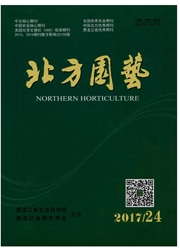

 中文摘要:
中文摘要:
以引起牡丹柱枝孢叶斑病的加拿大柱枝双孢霉(Cylindrocladium canadense)为试材,采用菌丝生长速率法和菌丝干重法研究了3类8种杀菌剂对病菌菌丝生长的影响,并进一步采用插片法及染色法,研究了多菌灵、氟环唑及嘧菌酯对菌丝线性生长及菌落形态的影响。结果表明:苯并咪唑类、三唑类及甲氧基丙烯酸酯类杀菌剂对病菌菌丝的线性生长及菌丝干重均有一定的抑制作用。3类杀菌剂均导致菌丝顶端分枝数增多、间距缩短;杀菌剂处理的菌落边缘菌丝茂密,放射性生长的幼龄菌丝束较少,向外扩展速度慢。3类杀菌剂对病菌都表现为抑菌作用,均可作为柱枝孢叶斑病化学防治的备选药剂而应用在牡丹病害的综合防控中。
 英文摘要:
英文摘要:
Taking Cylindrocladium canadense as material,which caused the brown leaf spot on cultivated tree peony in Luoyang,the inhibitory activity of eight fungicides against mycelial growth of C.canadense was determined by colony diameter assay and shaking method.The inhibitory mechanism of carbendazim,epoxiconazole and azoxystrobin were determined by inserting cover glass into medium and aniline blue staining.The results showed that three kinds of tested fungicides,including benzimidazoles,triazoles and strobilurins could strongly inhibit the mycelial growth,with the EC50value(the concentration of the fungicide causing a 50%reduction in the growth rate compared to an unamended control)from 0.261 7μg/mL to 40.981 5μg/mL on solid medium and the inhibition rate from 43.32%to 75.23%in liquid medium.The tested three kinds of fungicides could cause the increases of branching number and shortening of branching interval on hyphal tip.After amended with fungicides,the mycelia on colony margin was denser,the young mycelia which grew radially was less and the colony expanded more slowly than those with unamended fungicides.The three kinds of fungicides were the alternative pesticide and could be used in chemical control of the peony brown leaf spot.
 同期刊论文项目
同期刊论文项目
 同项目期刊论文
同项目期刊论文
 期刊信息
期刊信息
